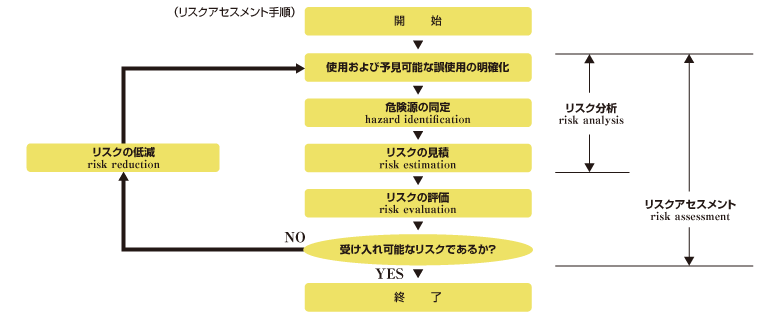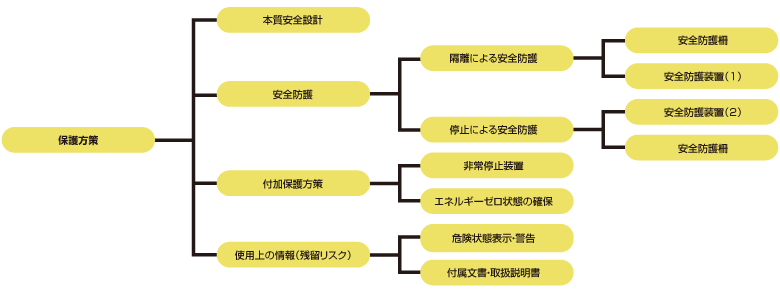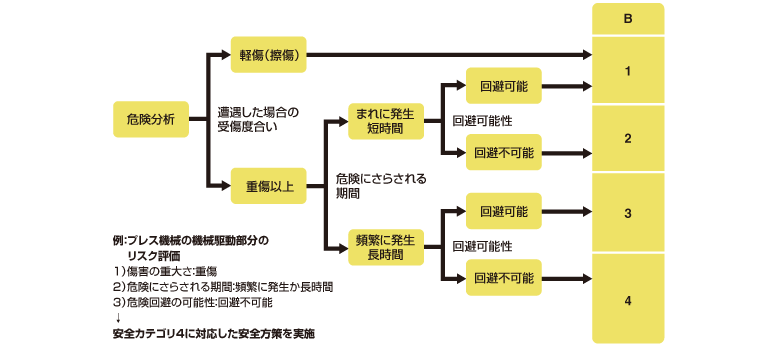Safety solutions
Safety standard explanation
What are safety standards?
International machine safety standards are organized by a hierarchical structure of A, B, and C standards.
● A standard (basic safety standard): ISO 12100
● B standard (group safety standard): ISO 13849-1, IEC 61508, etc.
● C standard: individual machine safety standard
ISO 12100 risk assessment
"Risk assessment" is to clarify the hazards hidden in the machine and evaluate the degree of danger (risk).

Protection measures to reduce ISO 12100 risk
International safety standards implement protective measures to mitigate risks until they are below acceptable levels.

EN ISO 13849-1 Safety category
"Safety category" is an index for determining specific safety measures from the results of risk assessment.

| Safety category | Summary of requirements | Ability to maintain safety functions |
|---|---|---|

|
・ To realize the purpose function of the safety-related part of the machine control system. | ・ When a defect occurs, the safety function may be impaired. |
|
・ Meet the requirements of Category B. ・ Use well-reliable and reliable components, and ensure safety by following the safety principles. |
・ Similar to Category B, but the reliability of the safety ensuring function of safety-related parts is high. | |
|
・ Meet the requirements of Category B. ・ To ensure safety, follow safety principles ・ Safety functions should be checked at appropriate intervals. |
・ The loss of the safety function is detected by the check, but the safety function is lost during the check interval time. | |
|
・ Meet the requirements of Category B. ・ To ensure safety, follow safety principles ・ Design requirement: A single failure should not impair the safety function. ・ A single defect should be detected as much as possible. |
・ A single failure does not impair the safety function -Although not all, it can detect failures. Accumulation of undetected failures may impair safety functions | |
|
・ Meet the requirements of Category B ・ To ensure safety, follow safety principles ・ Design requirement: A single failure must be detected at or before the execution of the safety function. If this cannot be done, do not impair safety functions by accumulating failures. |
・ If a failure occurs, the safety function is not compromised. ・ A failure is detected as a preventive measure to ensure that safety function implementation is in time before the safety function implementation. |
EN ISO 13849-1 Performance Level
The frequency of dangerous failures (failures in which the safety function does not work when necessary) and the probability of failure detection by diagnostics are comprehensively evaluated, and classified into five performance levels (PL) from a to e. I will.
● By intermediating the performance level (PL), the category and the safety integrity level (SIL) specified in the functional safety standard IEC 61508 can be referred to each other.
● Similar to the safety category, it is required by conducting a risk assessment from the viewpoints of “S: severity of failure”, “F: time in danger”, and “P: possibility of avoiding danger”.
Functional safety standard IEC 61508In recent years, due to advances in microprocessor technology, penetration of IT technology, and complicated control, there has been a demand for building a safety system using a microprocessor and software. In response to the demands of this era, the concept of functional safety was born, and in 2000 the functional safety standard IEC 61508 (functional safety of electrical / electronic / programmable electronic safety-related systems) was published. The PLC is also covered as the scope of application of the standard.

 Contact Us
Contact Us Call Center
Call Center

